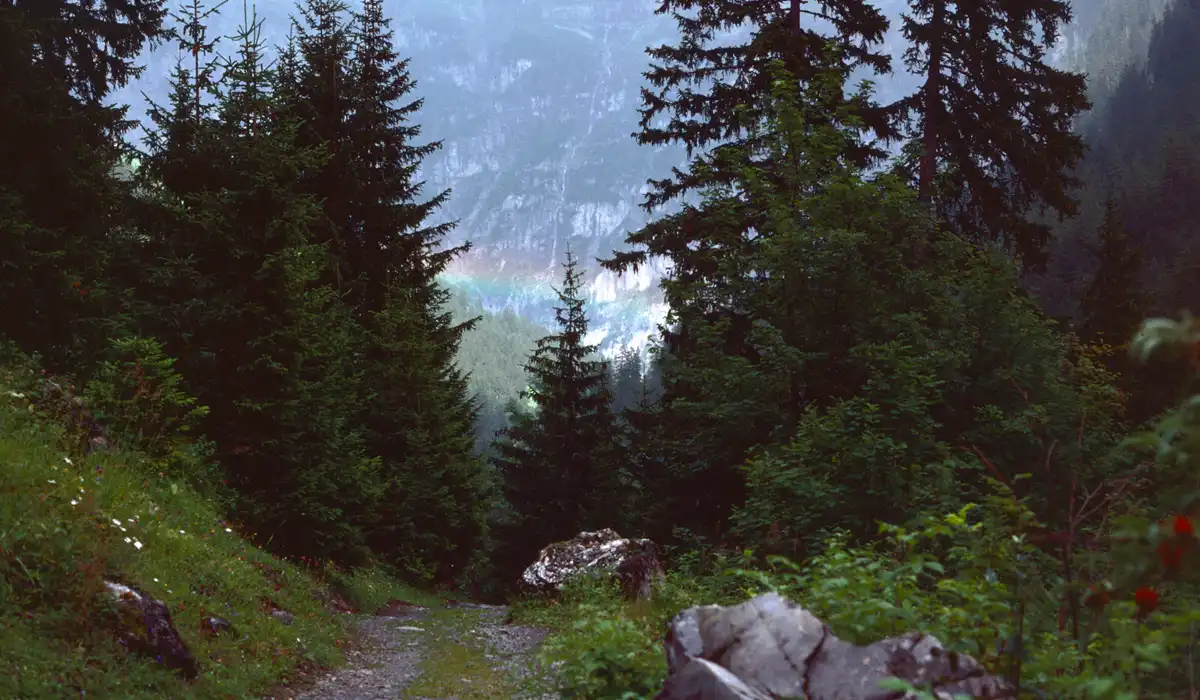I arrived at Interlaken, Switzerland, on a sunny day one summer. On the train there, I met 2 American women, who like me, were backpacking around Europe. Once in Interlaken, we explored the city together. The small city sits in a valley between 2 lakes, hemmed in by majestic mountains that stretch as far as the eye can see.
It was a great and fun afternoon.
Late afternoon I walked them to the youth hostel they were staying at, while we talked about what to explore tomorrow in this fabulous area.
Except I wasn’t staying at that youth hostel. The day before I’d booked space at a youth hostel in a little place called Gimmelwald, located up in a side valley. So I dashed to the train station, fully intending to be back down in Interlaken the next morning to catch up with my new friends.
Encountering the magic
All I remember of the train trip up the valley to Lauterbrunnen is a narrow valley with a river, the railroad and a road. Plus heavy rain. The tall cliffs on either side of the valley lost themselves into a gray mass of clouds.
I was going to the Lauterbrunnen valley because a friend insisted it was a place I absolutely mustn’t miss. It was that magic, she told me.
It didn’t seem so magic when I stepped off the train. The rain was still pouring down. The steep cliffs bordering the valley simply disappeared up into those dark rainclouds.
Even so, I would have loved to linger and explore. But it was getting late and I needed to board a bus to get to the upper end of the valley where I would catch an aerial cable car to finally get to this Gimmelwald place.
The aerial cableway went up very steeply and deposited me and a few others at a station that clung to a sloping mountainside 1600’ above the valley floor.
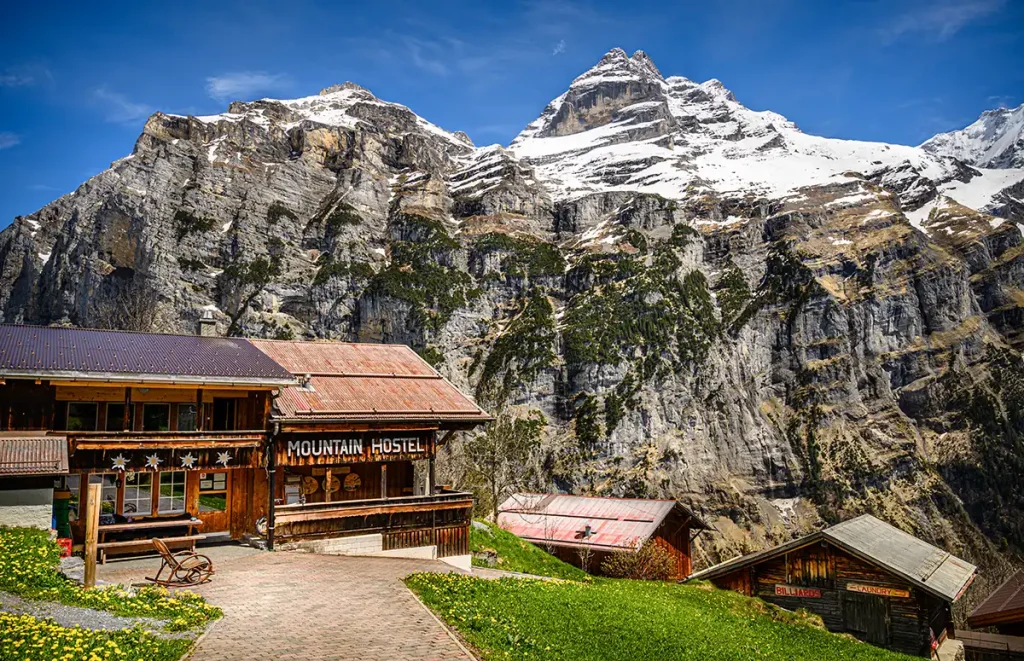
The mountain hostel
I had arrived in Gimmelwald. The youth hostel turned out to be in an old building. Really old. Dating back to the 1500s. I guessed it meant that it was solidly built, to have clung to the mountainside for that long.
Next morning came with rainclouds hanging in the valley. I looked out the bank of windows in the common room: straight ahead a rose a massive mountain. Actually 3 major peaks: The Eiger, the Monch and the Jungfrau. (The ogre, the monk and the virgin). The valley in-between was hidden by clouds.
It felt like being in an isolated part of the world, remote and cut off from the hubbub of everyday life. Everything had its own rhythm here.
Yesterday’s plan was to spend nights up here and go all the way down to Interlaken to catch up with my new friends. But I couldn’t bring myself to leave.
Nobody else was in a rush either.
A lot of hostels would lock you out during the day. Because you weren’t there to sit around the hostel. You were there to sightsee. Do things. Go places. Not here.
There was the guy from the Bronx, the girl from Canada, the American girl. Someone from Australia. And others. Truly an eclectic group.
Everyone seemed to love to hang out and talk. Philosophy. Religion. I noticed a Bible or two sitting around in the common room. A game of cards on the balcony. Someone sitting in a corner reading.
Everyone was welcome and everyone joined in.
Exploring a mystical place
When the rain cleared in the afternoon, I and a girl went for a walk along a path leading along a narrowing side valley. Past waterfalls. Across lush pastures. Amidst gentle, but tall fir trees.
We almost made to the bottom edge of one arm of the glacier before needing to turn back.
Somewhere along that walk, we overlooked the main Lauterbrunnen Vally and saw a rainbow. Down below us. The only time I’ve stood on solid ground and looked down on a rainbow.
Then a shared dinner and talking on the balcony until long after the last remnants of daylight had vanished behind the high mountains.
The next day was sunny and our ragtag group went hiking. An experience that almost cost us our lives, but ended well. I wrote about that experience in The Mountain.
That day of hiking in absolutely gorgeous weather, surrounded by a mountain panorama so startling it couldn’t possibly be real, further underscored what a truly unique place this was. We looked across the Lauterbrunnen Valley at the 3 mountain peaks and the huge glacier up there. Turning around the other direction we tried to try to catch a glimpse of the not so distant Schilthorn, with the revolving restaurant Piz Gloria, of James Bond fame.
So breathtaking and awesome, it couldn’t be real. Or could it?
The kind of place, on top of Europe that you don’t ever want to leave.
And not just because of the views.
It was like there was something in the air. Something that slowed down the pace. That made you savor life.

The last homely house
This was so unlike any other place I’d ever been. You might think that this deep valley high up in the mountains, with steep cliffs rising for hundreds of feet and waterfalls throwing themselves over the edge way up there, would feel constricting. Alien. Like a place that hemmed you in.
But it didn’t.
It felt strangely homely. Like a place where I could be comfortable and relax. Be myself. Connect with others who, while from all around the world, all felt the same sense of relaxed belonging here.
Eventually I had to leave. It was in the evening, as shadows already overtook the valley that I rode the aerial cableway down from Gimmelwald, the bus to the train station and the train down to Interlaken where I eventually boarded an overnight train.
Maybe that’s part of the mystery and majesty of Lauterbrunnen for me: I arrived on a train in pouring rain so couldn’t see that much of the passing into the valley and I left in the evening, when mounting shadows already hid much of the scenery along the train tracks.
It felt like I’d stepped out of the regular world and into a very different world that ran on its own time and priorities.
Not at all unlike what Bilbo felt when he arrived at Rivendell in The Hobbit. Or what Frodo, Sam, Merry and Pippin experienced when they came there after a harrowing journey from the Shire in The Lord of the Rings.
Where you’re in a place that you later remember as full of light and pleasantness and a feeling of security in a world full of challenges.

Laterbrunnen, meet Rivendell
I didn’t know then that there’s good reason for the comparison of my experience in the Lauterbrunnen Valley with Rivendell in Tolkien’s epic saga.
Because the Lauterbrunnen Valley is Rivendell. Or at least very much the inspiration for Tolkien’s Rivendell. We can see it in his drawings and paintings of Rivendell: Sketches of Rivendell on the Tolkien Estate website (scroll down for Rivendell) and a side-by-side of a painting of Rivendell with photo of the Lauterbrunnen Valley.
It’s all there: The deep valley, the tall cliffs on both sides, the mountain peaks rising beyond and above it all. The many waterfalls cascading down into the valley.
The real thing certainly did feel like a place where elves could appear at any time (and even a hobbit or two pop in).
I see why the Lauterbrunnen Valley made such an impression on the 19-year-old Tolkien when he hiked the area with a group of friends in 1911. If he sensed anything of the uniqueness of the place and how the pace changed there, apart from the outside world, then that’s plenty of inspiration for a place that would be a refuge in a changing and dangerous world. A place of healing and quiet strength.
In The Hobbit Tolkien describes how travelers are going across a seemingly endless land of moors with ever so distant mountains. Reminds me of driving across eastern Colorado. For the longest time seeing mountains at the horizon and seemingly forever grassland right up to them. Then you get much closer and realize there are all these communities located where the plain meets the foothills.
Similarly the travelers in The Hobbit come across a deep valley hidden in an endless land and after descending a challenging path, they arrive at the Last Homely House where Elrond lives. They’re among elves. In a place totally and entirely different from the surrounding landscape.
There are of course plenty of other valleys in the Swiss Alps. Many of them much wider and bigger. It’s Switzerland. There are always mountains around. What makes the Lauterbrunnen Valley so unique is how long and narrow it is. The sheer mountain sides rising up, hemming it in, but also hiding it until you’re suitably close.
The valley is all the more impressive since right next to it is the massive Jungfrau area with 3 spectacular mountain tops and a major glacier.
From Lauterbrunnen in the valley to the top of the Jungfrau glacier is a vertical difference of 8,730 feet (or 1.65 miles). The valley sides rise up vertically or nearly vertically for about 1,600 feet. Yes, that’s very impressive.
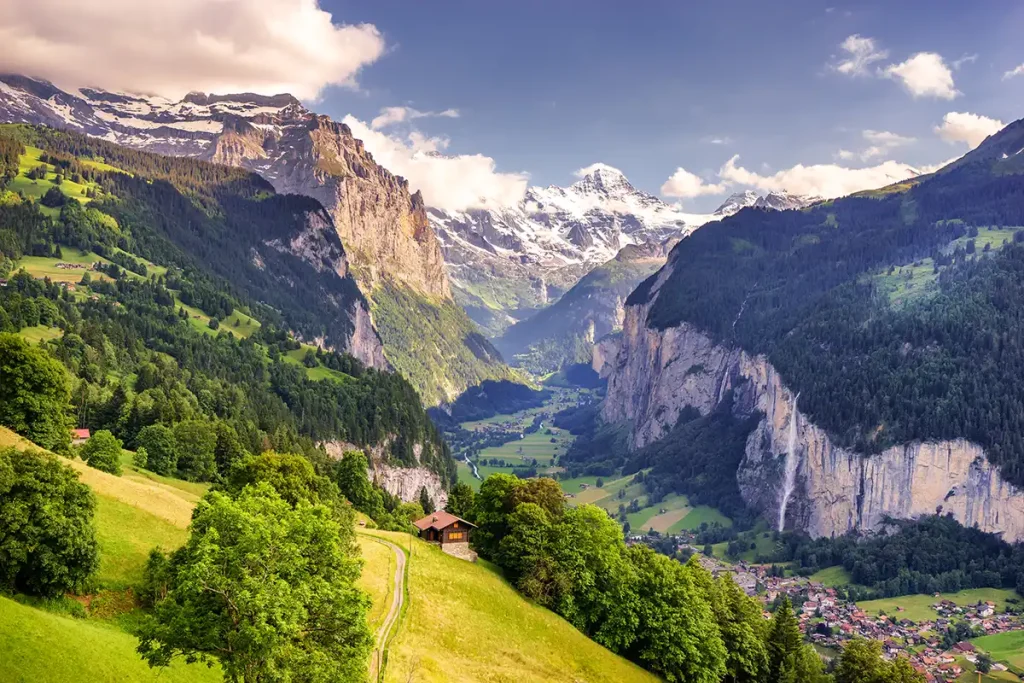
A place of healing and rejuvenation
Rivendell is a place of rejuvenation. Bilbo goes there after turning the ring over to Frodo. Being the keeper of the Ring for a long time has affected him and it’s at Rivendell he finds rest and peace.
It’s a place of healing. Frodo and friends are worn out and injured when they come there. They are healed and strengthened.
It’s a place for strategy and wisdom. The council determines how to handle the ring.
It’s a stronghold. The forces of darkness were not able to overcome it. Even the witch-king of Angmar failed.
It’s outside regular time. Perception of time is changed. The elves live forever. The seasons of men outside don’t affect the rhythm inside.
It’s a place sustained by elven magic.
Not saying that the Lauterbrunnen Valley matches that by any means. No earthly place could do that. Because Rivendell is also a vision of a heavenly, otherworldly place.
But my time in the Lauterbrunnen Valley was marked by rejuvenation. It was just plain refreshing to be there, in this valley high up in the mountains, on the roof of Europe. I felt invigorated just being there.
The way this motley collection of travelers from around the world, came together at the hostel to exchange ideas. Share thoughts. Play games. Go for walks. Explore. It brought us all together. It was an atmosphere I didn’t encounter in many other hostels. Just a few days later I was in a hostel in the Netherlands where people stuck hard to the groups they came and traveled with. No interaction with others. That was not the way of the hostel in the valley.
Time did change in the Valley. Because nobody was going anywhere that time mattered very much. The pace was relaxed. So we feel like sitting up until long after the last hints of daylight are gone behind the mountains? To discuss philosophy in the dark? Sure, we can do that. Feel like going for a walk right now? Why not?
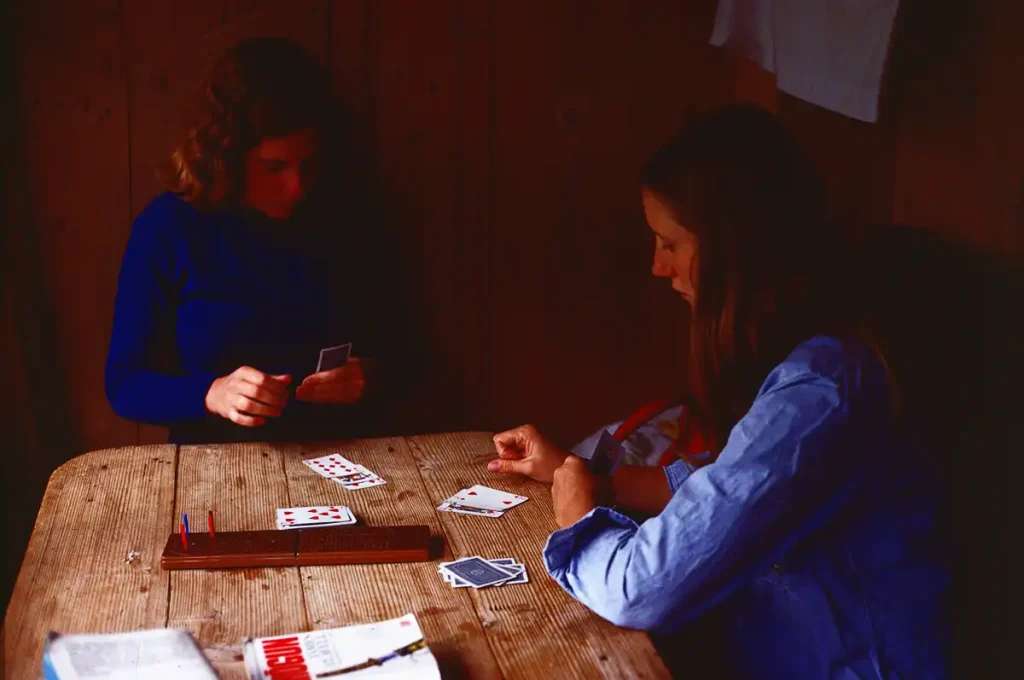
Savor the present
We all knew we weren’t going to be there forever, but we were there right then and that was good enough. Be in the moment. Savor the present.
A place for strategy and wisdom, with counsels. Okay, so no great plans for the rest of our lives were made there. But I do recall standing on a mountain meadow there, looking at the mountains surrounding the valley and realizing some things about my life.
I had made many plans for what I wanted to do when I grew up. I went to photography school in preparation for becoming a film maker. And then I was worn out with school. I did my military service. I worked in a harbor (a job I was going back to when I finally returned home after this trip).
And I didn’t really know what I wanted to do long-term.
Except that day it became clear. I wanted to tell stories. I wanted to get on with making films. Documentaries. Films that made life better — made the world a better place.
Back home after this trip, I started the process to apply to schools for film and broadcasting. The die was cast. On a meadow above the Lauterbrunnen Valley.
Forces of nature, power of growth
The Lauterbrunnen Valley is a place where it’s easy to both see how tenacious people can be. Some of the villages there, like Gimmelwald, cling to a mountain slope high above the main valley floor. People have lived in that spot since the Middle Ages, if not before. Maybe because there’s only one way in. Not like enemies are going to trek across the mountain range or the glacier. So it was defendable. And you could sustain life there. Apparently quite well enough.
It’s also easy to see the forces of nature at play. What massive forces were required to carve out this valley out of rock? I can only vaguely imagine what the glacier would have been like that dug and ground out this valley. 1,600 feet high cliff sides. That’s simply beyond human grasp.
So on the one hand absolutely massive force. Violence. Force. And on the other, the power of growth. Because wherever something can catch root, there is growth here. Trees hanging on to mountain slopes. A tuft of grass on a tiny rock outcropping. And flowers. Beauty everywhere.

Living Rivendell
I feel so blessed to have been able to spend some time in this wonderful space. And so clearly see why this valley inspired Tolkien as he envisioned the elvish Imladris, known to humans as Rivendell.
We all at some time or other need a Rivendell place and experience in our lives. A gentle place to recharge, to proceed at a different pace than everyday life.
On that level, Rivendell may look very different for different people. It may be as simple and close as being able to go sit by the local river or shore for a while. Or a walk through nature. Unconnected and with time to reflect and actually think.
Part of the Rivendell experience is also other people. With whom we can interact to discover more about ourselves, them and the world out there.
In The Lord of the Rings, Rivendell is a key milestone and game changer. Gandalf formulated a plan for Frodo to simply get the One Ring out of the Shire as a first step toward dealing with the threat it posed. At Rivendell the much bigger plan for how to deal with the Ring once and for all was shaped. And the new adventure resourced.
Rivendell wasn’t and isn’t about longing for what used to be by looking backward. It’s not the end. Nor is it entirely internal. It’s about finding strength to take on the biggest challenges ahead. To discover a viable path forward.
Because we don’t stay at Rivendell forever. I had a short while in the Lauterbrunnen Valley. But the experience has stayed with me for a lifetime.
Photos by the author (4) unless otherwise noted by the photo

Sister of Rivendell
Discover how the Lauterbrunnen Valley, as well as the entire Jungfrau Region inspired J.R.R. Tolkien’s Middle-earth.
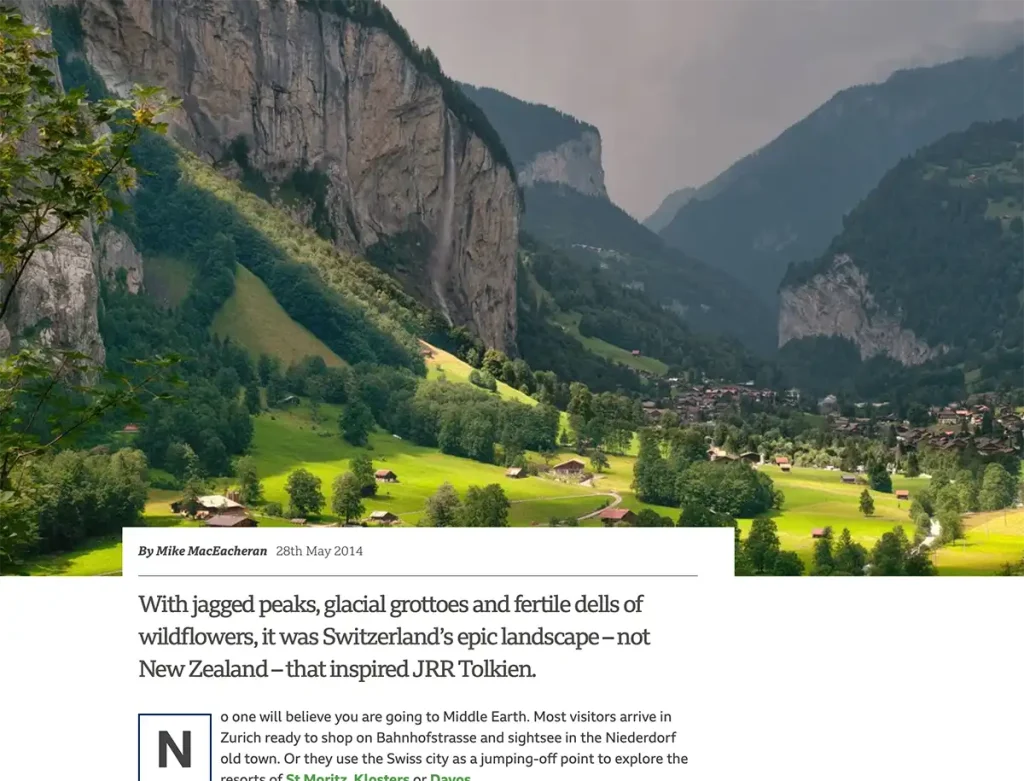
In Alpine villages, Hobbits lurk
Middle-earth in Switzerland: The places that inspired Tolkien long before he wrote The Hobbit and The Lord of the Rings.
https://www.bbc.com/travel/article/20140523-in-alpine-villages-hobbits-lurk

